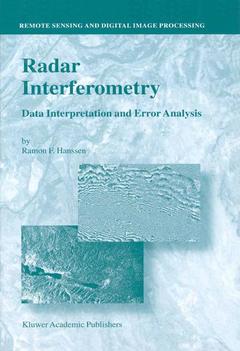Description
Radar Interferometry, Softcover reprint of the original 1st ed. 2001
Data Interpretation and Error Analysis
Remote Sensing and Digital Image Processing Series, Vol. 2
Author: Hanssen Ramon F.
Language: English
Subjects for Radar Interferometry:
Radar interferometry: data interpretation and error analysis (paperback) previously published in hardcover (series: remote sensing and
Publication date: 12-2010
308 p. · 15.2x22.9 cm · Paperback
Publication date: 12-2010
308 p. · 15.2x22.9 cm · Paperback
232.09 €
Subject to availability at the publisher.
Add to cart
Radar interferometry. Data interpretation and error analysis (Remote sensing and digital image processing Volume 2) POD
Publication date: 04-2001
Support: Print on demand
Publication date: 04-2001
Support: Print on demand
Description
/li>Contents
/li>Comment
/li>
This book is the product of five and a half years of research dedicated to the und- standing of radar interferometry, a relatively new space-geodetic technique for m- suring the earth?s topography and its deformation. The main reason for undertaking this work, early 1995, was the fact that this technique proved to be extremely useful for wide-scale, fine-resolution deformation measurements. Especially the interf- ometric products from the ERS-1 satellite provided beautiful first results?several interferometric images appeared as highlights on the cover of journals such as Nature and Science. Accuracies of a few millimeters in the radar line of sight were claimed in semi-continuous image data acquired globally, irrespective of cloud cover or solar illumination. Unfortunately, because of the relative lack of supportive observations at these resolutions and accuracies, validation of the precision and reliability of the results remained an issue of concern. From a geodetic point of view, several survey techniques are commonly available to measure a specific geophysical phenomenon. To make an optimal choice between these techniques it is important to have a uniform and quantitative approach for describing the errors and how these errors propagate to the estimated parameters. In this context, the research described in this book was initiated. It describes issues involved with different types of errors, induced by the sensor, the data processing, satellite positioning accuracy, atmospheric propagation, and scattering character- tics. Nevertheless, as the first item in the subtitle ?Data Interpretation and Error Analysis? suggests, data interpretation is not always straightforward.
Preface. Summary. Nomenclature. 1. Introduction. 2. Radar system theory and interferometric processing. 3. Functional model for radar interferometry. 4. Stochastic model for radar interferometry. 5. Data analysis and interpretation for deformation monitoring. 6. Atmospheric monitoring. 7. Conclusions and recommendations. A. Comparison neutral delay GPS and InSAR. B. Structure function and power spectrum. Bibliography. About the Author. Index.
From the reviews:'As satellite coverage improves, radar interferometric techniques are becoming powerful and accessible tools for geodetic studies. ... and are also applicable to the study of atmospheric conditions. ... a guidebook for people who are already familiar with the method. ... In conclusion, this is a well written, well presented book ... . This book should be quite useful as a guide for applying InSAR techniques and evaluating the possible errors and the confidence to be placed on the results.' (F. A. Nava, Pure and Applied Geophysics, Vol. 168, 2011)
© 2024 LAVOISIER S.A.S.
These books may interest you

Radar Remote Sensing of Urban Areas 105.49 €



